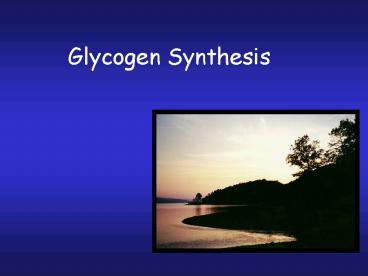Glycogen Synthesis - PowerPoint PPT Presentation
1 / 22
Title:
Glycogen Synthesis
Description:
Fat cannot provide energy under anaerobic conditions ... mutase. UDP-glucose. pyrophosphorylase. Glycogenin. Glycogen Synthase. Glycosyl-(4- 6) -transferase ... – PowerPoint PPT presentation
Number of Views:112
Avg rating:3.0/5.0
Title: Glycogen Synthesis
1
Glycogen Synthesis
2
Topics Glycogen Synthesis
- Glycogen convenient condensed energy source
- Glycogen synthesis pathway
- Tissue differences in glycogen synthesis
3
Why store fuel as Glycogen rather than Fat?
- Fat is not mobilized as quickly
- Fat cannot provide energy under anaerobic
conditions - Fat cannot (easily?) be converted to glucose to
buffer blood glucose (brain/neurons)
4
Why not store glucose monomer?
- Same amount of reserve would require 0.4 M
glucose in cells! Cells would burst from osmotic
pressure - Reserve in glycogenintracellular is only 0.01
uM, Causing no osmotic pressure problem
5
Glycogen Facts.
- A branched-chain of D-glucose
- 400 g glycogen in resting muscle
- (1-2 wet weight)
- 100 g glycogen in fed liver
- (6-8 wet weight)
- Single glycogen molecule up to 100,000,000 Da
- Exists as granules in cell cytoplasm. Granule
contains enzymes for both glycogenesis
glycogenolysis
6
Gluconeogenesis can feed into synthesis of
glycogen
7
Glycogen synthesis pathway
8
Overall glycogen synthesis
1
- Steps
- Isomerization G6P -gt G1P
- Activation by UTP
- Glycogenin priming
- Extension by Glycogen Synthase
- Branching
- Repeat 4 5
2
3
4
5
6
9
The enzymes
0
1
2
3
4
5
6
10
Reactions of glycogen synthesis
- Investment of
- 1 mole UTP
- 1 mole ATP
11
Activation of glucose by UTP is necessary for
synthetic reactions
1 mole of ATP invested
12
Reaction is driven by subsequent hydrolysis of
pyrophosphate
13
Glycogen Synthase reaction
can make 1-gt4 but not 1-gt6 (branch) linkages
14
The branching reaction
- Glycosyl-transferase moves a large linear
chunk to a branch position (C6) - Increases density of polymer
- Increases solubility of polymer (e.g vs.
cellulose)
15
Tissue differences in glycogen synthesis
16
Glycogen serves different purposes in liver and
muscle
Liver blood sugar buffering (free glucose is
made, exported) Muscle stored fuel (no free
glucose intermediate G6P is used)
17
Muscle fibers synthesize and store glycogen
during inactivity
- During activity uses
- free glucose
- stored glycogen
- glucose from the liver (mobilized glycogen)
Fasting does NOT deplete muscle glycogen for
many weeks, whereas exercise depletes it in
hours!
18
Brain cells/neurons do not store glycogen
Get glucose from the liver glycogen
19
Liver responds to high blood glucose by
synthesizing glycogen
Exports glucose to brain, muscle, RBCs Liver
glycogen is depleted during a fast (gt 24
h) Purpose of glycogen is for blood glucose
buffering
20
Glycogen synthesis and degradation are regulated
by enzyme phosphorylation(Insulin vs. Glucagon)
21
liver
muscle
Insulin signalling pathway stimulates glycogen
synthesis in both muscle and liver cells
22
- You should know
- Advantages of glycogen as a stored fuel source
- Reactions of glycogen synthesis
- Roles of key enzymes involved
- How tissues differ in synthesis and utilization































